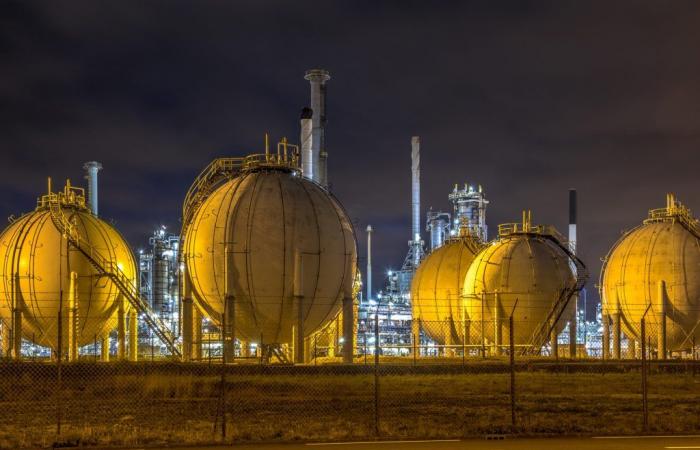Analysts say worries about another supply disruption from Russia and unplanned outages in Norway – now Europe’s largest gas supplier – will keep markets tense and prices high towards the end of the year
In Europe, natural gas prices have increased by 40% in the last three months, despite the fact that the EU has emerged from the winter season with a record level of gas still in storage. The rise in prices during the so-called shoulder season – when demand for domestic gas is low – is the result of concerns over supply disruptions and increased LNG imports into Asia due to lower spot prices and heat waves in some parts of China, as well as in India and other Southeast Asian countries.
The greater flows of LNG directed to Asia – writes Tsvetana Paraskova on Oilprice – have left Europe with fewer imports in the spring, and the notable surplus in European storage, although still at record levels and well above seasonal averages, is is reduced from the end of the heating season.
RISKS ON GAS SUPPLY IN EUROPE
Therefore, risks remain for gas supply in Europe, as demonstrated by the most recent peaks in the continent’s reference prices. Analysts say Europe is likely to fill storage before the November 1 deadline for the second year in a row, but concerns about another supply disruption from Russia and unplanned outages in Norway – which is now the largest gas supplier to Europe – will keep markets tense and prices high towards the end of the year.
RECORD STORAGE LEVELS ARE BEGINNING TO DECREASE
According to data from Gas Infrastructure Europe, gas storage sites in the European Union were 72.3% full as of June 11. The refueling season has begun, and the EU has increased storage levels compared to 58% at the end of the winter, which in itself represented a record level of gas available for the end of a heating season, thanks to a milder and weak demand from industry.
Now that the fueling season is in full swing, the start was unusually slow: It was the second slowest start since 2012 and well below the decade-long seasonal average, according to data compiled by Reuters analyst John Kemp. The excess of gas supplies, compared to the 10-year average, decreased at the beginning of June compared to the end of the heating season on March 31.
Nonetheless, storage levels continue to be well above seasonal averages, and it is likely that Europe will reach its full fill target well before the November 1st deadline. However, slower-than-usual gas accumulation has put upward pressure on European prices, which has also reflected supply risks from Norway and Russia in recent weeks. Plus, Asia is increasing competition for LNG supplies as heatwaves hit the south and southeast of the continent, diverting cargoes away from Europe.
RISKS ON SUPPLY ARE INCREASING GAS PRICES IN EUROPE
Benchmark natural gas prices in Europe have already increased on two occasions in June as the market feared supply shocks. First, Dutch TTF natural gas futures in early June rose 10% in a single day, reaching their highest level in 6 months, while supply from Norway plummeted due to unplanned outages.
The Sleipner hub, off Norway, was closed, also halting operations at the onshore processing plant in Nyhamna for several days. The Sleipner Riser offshore hub is a connection point for pipelines connecting the Nyhamna facility on the west coast of Norway to the Easington terminal in the United Kingdom. The unplanned outage highlighted the vulnerability of Europe, which has relied on natural gas imports since Norway became Europe’s top gas supplier following Russia’s invasion of Ukraine and the collapse of Russian exports.
UNCERTAINTY ABOUT RUSSIAN SUPPLIES
This week, uncertainty over the remaining supply of Russian gas via pipelines to Europe has pushed up prices at the Dutch hub. Prices rose 3% on Wednesday morning after Germany’s Uniper terminated contracts to supply Russian gas, leaving the market concerned about remaining flows from Russia to Europe. Uniper’s announcement and OMV’s recent warning – that Gazprom could stop supplying gas to Austria due to a foreign court ruling that could stop OMV’s payments to Gazprom Export – have reignited concerns about the possibility that Gazprom could further reduce Russian supplies.
GAS PRICES IN ASIA AND EUROPEAN STORAGE
According to Wood Mackenzie, as prices in Europe have risen 40% in three months and spot LNG prices in Asia are hovering around 6-month highs, higher Asian prices in the near term could create headwinds to LNG growth. LNG demand in Asia. “Lower European demand has depressed prices and pushed LNG into Asia, with imports to China alone rising by 22%,” said Lucy Cullen, research director EMEA Gas & LNG Research at Wood Mackenzie.
“Looking ahead, high prices are likely to provide some headwinds to Asian demand growth in the near term. As a result, European storage levels are on track to reach full capacity by the end of September and remain there until October,” Cullen added.
However, Europe still faces supply risks, the biggest of which is on Russian gas, “whether through an early disruption of flows through Ukraine or as a consequence of pending arbitration proceedings between European energy companies and Gazprom”. Furthermore, unplanned or extended Norwegian maintenance is set to play a more significant role on European gas prices and the pace of storage filling, Cullen said.






